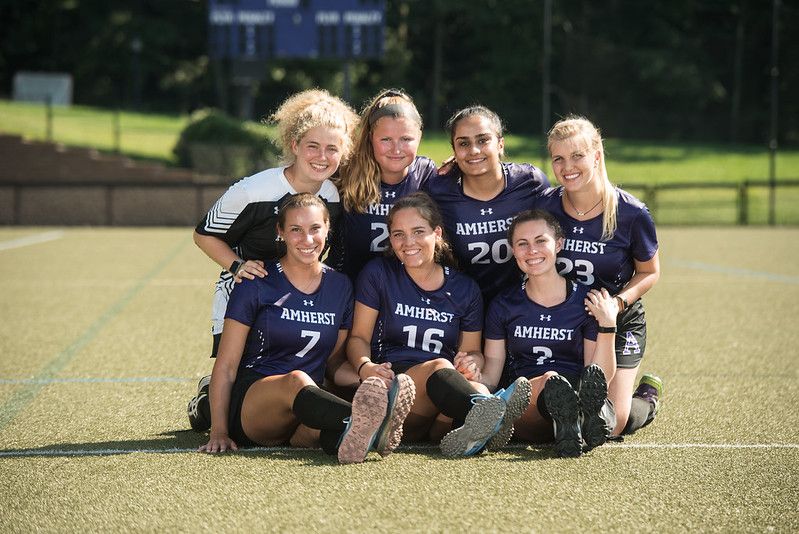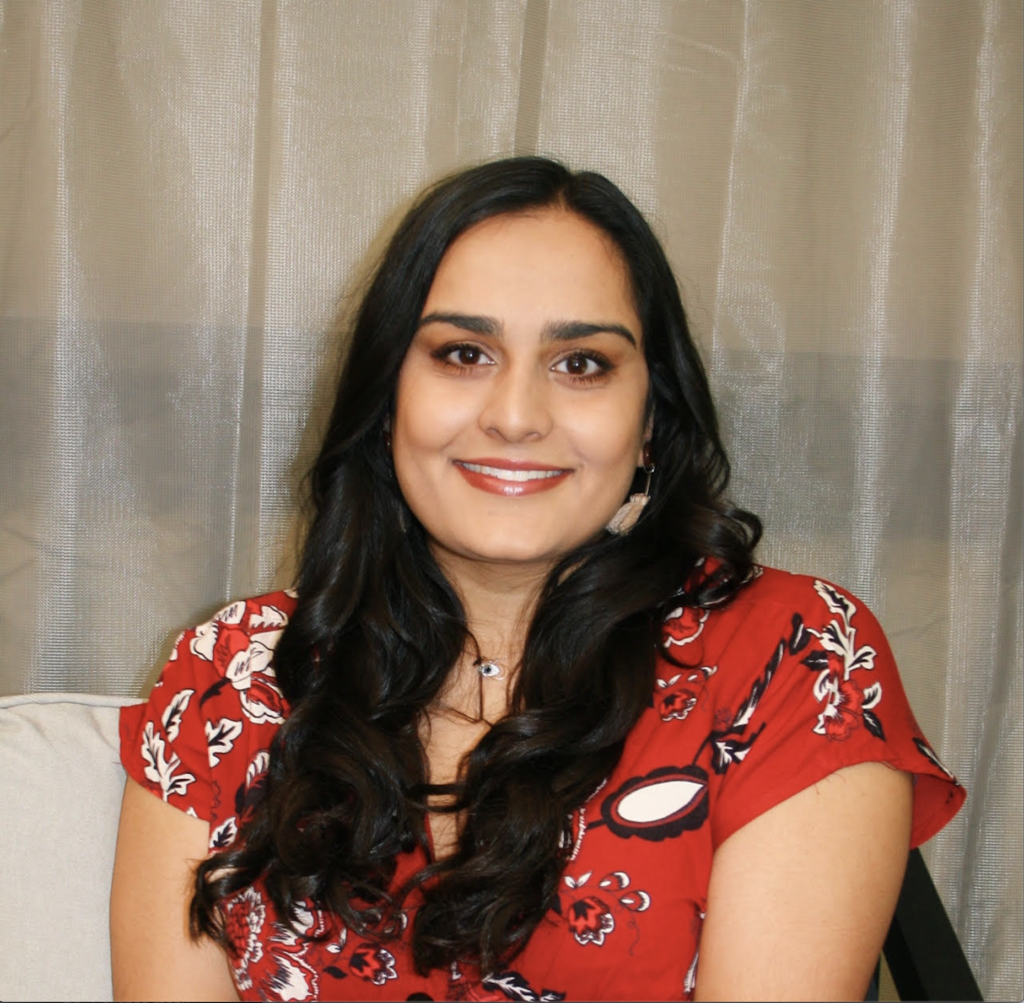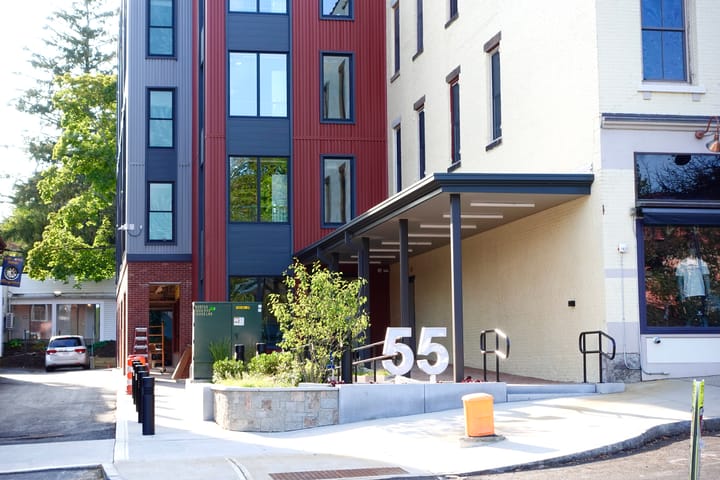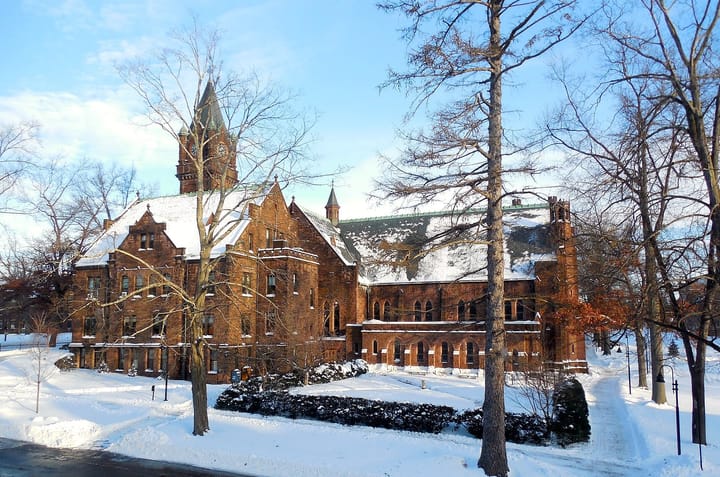Yasmeen Saeed: A Winding Road to Leadership


In the face of a devastating and painful injury, most individuals can think of nothing more than returning to normal, doing the things they did before and forgetting the trauma.
That is not Yasmeen Saeed ’20. Rather than focusing solely on recovering, Saeed turned her injury into one of the most pivotal and educational moments of her college career, setting her on a course towards advocacy and expertise that few can match.
Saeed’s path to Amherst and to her interests was not linear. In fact, her first memory of Amherst was, quite literally, circuitous. As Saeed mentioned, she did not even leave her car, driving one loop around the quad before leaving.
“I grew up in Glastonbury, CT, which is a small suburb right outside of Hartford, and one of the big reasons that Amherst was even on my radar was because I got recruited to play field hockey,” said Saeed.
“My first impression of Amherst was, actually, horrible,” Saeed laughed. “I went in the middle of winter during a snowstorm, and I was really sick. I think I actually had pneumonia.”
At that point, she wondered whether or not Amherst was the place for her, and effectively checked Amherst off her list.
Luckily, however, Saeed’s future field hockey coach got in contact with her during the summer. At her next visit, she got out of her car and saw the campus, beyond Quadrangle Drive. After going on a tour, Saeed ultimately decided that Amherst was a place that she could see herself attending for the next four years.
Saeed continued, “One of the reasons I liked Amherst so much was the diversity, and, coming from Glastonbury, it was nice to see a place that had a different, more worldly perspective. That was one of the things that drew me to Amherst.”
A Leader in CACSAC
Saeed’s initial experience at Amherst was one that is familiar to most, if not all new students. “That first year, I tended to stay in the circles that I had felt most comfortable in,” like the field hockey team.
By the end of the year, however, Saeed found a group that would come to be a defining feature to her experience at Amherst: CACSAC, short for the Council of Amherst College Student-Athletes of Color.
Saeed didn’t attend many meetings her first year, but, soon enough, she would be pulled into the community it offered.
“Sophomore year, I really started to get more involved in CACSAC and that part of campus, and, once I started looking for it, I definitely found that it was there. When I found CACSAC and started regularly going to meetings, it felt like the part of Amherst that I was missing out on and made my experience more complete,” she said. “That was an underrated part of Amherst for me, just sitting down with a bunch of cool people, not having an agenda, meeting new people.”
“Junior year, I went even more frequently and really could feel myself coming into my own within the group, establishing my voice in CACSAC,” Saeed added.
It was during that junior year that Saeed took up her first position on the executive board of CACSAC. In her role, she helped organize a program that traced the history of minority athletes’ representation at Amherst as a percentage of the student body and of the varsity athletes.
Senior year, Saeed would take on even more responsibility, acceding to the role of president and leading the very organization that had become a formative part of her experience at the college.
“One thing that we did during my year as president was engaging more with the athletic department. We invited all the coaches to come to one of our weekly meetings and had a really good turn-out,” Saeed said. “About 20 coaches and 80 or so CACSAC members came, and it was the first time that any of us had the opportunity to put things out in the open and for student-athletes of color to ask questions about recruiting, retainment, what coaches are looking for and how they are working to improve diversity on their teams.”
The organization also hosted an allies meeting, in which about 120 student-athletes attended to hear about CACSAC’s work.
“One of the things we discussed was how Amherst might have a lot of the statistics, but things can feel kind of like a show sometimes, that things are not actually as good in practice as they can appear on paper. For example, Amherst athletics can appear relatively racially diverse, but it’s not necessarily socio-economically diverse, and how that [is] one thing that is sometimes left out of diversity conversation.”
Saeed had an additional role to play within the Athletic Department’s diversity and inclusion conversations, serving on the department’s Diversity and Inclusion Taskforce. It was here where she got an institutional-level perspective on initiatives and programs designed to improve equality and inclusion within athletics to make sure sports are reflective of the college’s broader goals.
Speaking about her term as president, Saeed was quick to dismiss claims that she herself was responsible, steadfastly refusing to speak on behalf of CACSAC and her executive board and instead choosing to highlight the camaraderie found within the organization.
“It was so much fun,” Saeed remarked. “There would be serious conversations, but other times, we would just sit around and talk. Having that space to sit around and talk, to do nothing and meet new people can be overlooked. If you ask most people in CACSAC about what their favorite thing was, I would think that it would be that.”
An Injury Leads to More Opportunity
However, despite Saeed’s obvious passion for her work with CACSAC, it is work that she admits might not have happened but for a devastating injury to her ankle she suffered playing field hockey her first year at Amherst.
“The biggest thing that I got out of field hockey were the friendships and relationships. I obviously couldn’t get that much athletic accomplishment out of it because of my injury, which ultimately contributed to me stepping away from the sport after my junior year.”
Sidelined from the sport that she loved, Saeed said, “Moving away from field hockey made me have to figure out a different role that wasn’t on the field.” Saeed continued, “I wanted my teammates to feel like they were the best versions of themselves, and they didn’t necessarily have to be tied to how they were performing on the field.”
Heather Brennan ’20, a teammate and close friend, remarked, “As a leader, she was reliable and approachable.” Brennan continued, “She spoke her mind but spoke with respect and kindness. I think that although Yaz’s injury prevented her from playing in games, it really didn’t prevent her from giving her all to the team. She was still there at every practice and every game, doing whatever the coaches asked of her and more, and her whole heart was dedicated to wanting the team to succeed.”
“Having her as a teammate for me has meant feeling the most incredible support and love,” said Brennan.
Brennan’s sentiments were echoed by another of Saeed’s close friends and teammates, Elizabeth Sturley ’20, who said, “[Saeed] did so much work behind the scenes or mundane tasks without the acknowledgement or gratitude she deserved. That shows her true reason for acting was purely out of her good heart and desire to help the team.”
“Getting injured opened up a lot of opportunities for things that I otherwise don’t think I would have explored,” Saeed said.“Moving away from field hockey, getting injured, and that whole experience really guided my career aspirations.”

Orthopedics, the field that Saeed now intends to go into, became a natural step as a result of her experiences. Saeed focused her summers on gaining experience that would both help her further that goal and help her understand just what had happened to herself.
The summer after her sophomore year, she worked as an intern on an orthopedic trauma project at Harvard Medical School.
“I remember it so clearly: I interviewed on March 12 in Boston, and on March 13, at 7:00 a.m., I went in and had a second surgery on my ankle,” she said. Saeed ultimately accepted the position, and said, “I’m so glad that I was able to do that, because I struggled a lot with feeling the whole situation was out of my control. I had a lot of personal negativity around [my experiences with surgery], and I was able to channel a lot of that back into a more positive experience.”
The summer following her junior year, Saeed continued to work in Orthopedics at Brigham and Women’s Hospital. She plans on applying to medical school after graduation, hopeful of a career in the very specialty in which she has had such fortunate and unfortunate experiences.
Sturley complimented Saeed’s drive and determination to make the best of an unfortunate situation, saying, “I am so proud of how much I’ve seen Yaz come into herself during her time in college. She has always had this resilience that I admired, but I think senior year she was able to see that more herself, giving her the confidence and strength to know her own worth and value and not put up with anything less. I think that has always been inside of her, but she has grown into it.”
Writing a Thesis and Planning for the Future
During her senior year, Saeed threw herself into her senior thesis, a project that she says she would not have been able to complete had she not had the guidance of her thesis advisor, Monica Ringer, professor of history and Asian languages and civilizations.
Saeed’s thesis stemmed from her history department capstone, titled “Turkey: From Ataturk to Erdogan,” and explored how the past has been mythologized. Using primary sources — in particular, political cartoons — Saeed compares former president of Turkey Mustafa Kemal Ataturk and the country’s current president Recep Tayyip Erdogan. Specifically, she looked at the ways each leader understood the past and mythologized it for their own present purposes and to construct a generation of national identity.
As Ringer said, “Yasmeen developed from someone interested in the content of history to a practitioner of history.” Ringer praised Saeed’s work, stating simply, “Her work was theoretically sophisticated and innovative.”
Saeed’s time at Amherst has not been one with a linear path, but rather one that has been focused on turning her pain from an injury into a series of successes, on a passion for medicine that will last long after graduation and on helping others.
Brennan touched on this last piece, saying, “She never made me doubt that she would be there for me, whatever, was to come.”
She continued, “Yaz taught me that a friend can ask nothing of you but your company. She showed me unselfish friendship; she showed me the subtlety of compassion; and she showed me how to make the little moments in life special.”
Indeed, Saeed has an unconscious ability to impact those around her, and a radical kindness that will serve those around her before herself, no matter what she chooses to do in the future.
As Brennan summed up, “I’m so excited to see where she’ll go.”
Sturley echoed Brennan, extolling, “Anyone who has the opportunity to know [Saeed] and love her is one of the luckiest people in the world.”





Comments ()